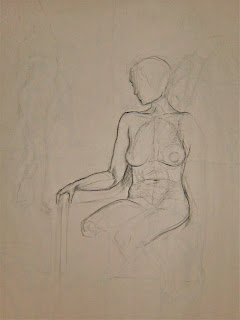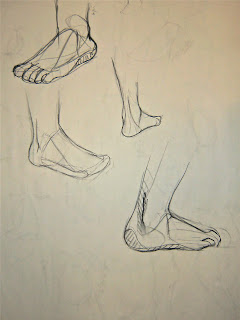Wednesday, April 20, 2011
Week 12
Monday, April 18, 2011
Week 11
After I worked on the skeleton most of monday, wednesday and friday I started working on the live model hands, and how the muscles interacted. It was difficult to capture the knuckles just right, because many times you cant see the bone actually, but have to draw it as if it were there underneath anyways. Shading and adding value helped a lot though, which is something I haven't had a whole lot of time to add into my drawings. We spent the entire class time working just on hands, so it was nice to get detailed with them. Hands say so much about a person...rough, delicate, strong, tiny...so interesting.
Week 10
Its hard to capture this when the muscles are completely stretched out, as in the top drawing. I think I drew the arm a bit more slim than it really is...its probably a bit more flexed than that. Slowly working our way down the arm and on to the hand next week!
Week 9
We've continued down the arm and into the forearm this past week. Monday we learned about the elbow and its connecting muscles. Some of the landmarks on the arm were the Medial Epicondyle and the Ulna. The Medial Epicondyle is the bone that stick out on your elbow, and the ulna is the part of the bone closer towards the wrist that has a slight bump. I don't know why, but I think this bone is really lovely.. Its a simple little 'chink' at the wrist that really adds so much beauty to the arm. The muscles on the arm, such as the Flexor Carpi Radialis make quite the twist in the arm when changing from a 'palms up' to a 'palms down' view. When the palms are up and bones are parallel, this is called "supine" (untwisted). When are palms are down and the bones are crossed, this is called "prone". Its interesting to think this way, because I've always thought that when we have palms up are arms are being bent a twisted way, but its actually the other way around, so when we're casually walking are muscles are slightly curved/twisted... Humans are so weird.
The clay has been getting really complicated in the arms....at first mine all started out very small and thin because the book never really has accurate pictures of anything...but after looking at other classmates and the teacher example...and of course the live model, I realized people, in fact, do not have spaghetti strings for arms. ;)
Friday, April 15, 2011
Week 8
Sunday, April 3, 2011
Week 7
The foot. Oof. Hasn't been easy. There are so many different little bones and muscles involved, its enough to drive you crazy. The clay mannequin's, as always, do help a lot. There are many tendons going down to each toe that really help shape the foot, as well as the pinky toe muscles. The pink toe in and of itself is a strange thing; it almost looks like another foot protruding off of a 4 toed foot. Weird. Toenails are also difficult, some grow more on top of the toe, while others are closer to the front/ground surface. It gets even harder when the toe show not even the slightest indication of bone structure underneath, only a long blob of flesh. The ankle is a good landmark when drawing, it gives direction to where the heel stands.
Subscribe to:
Posts (Atom)













